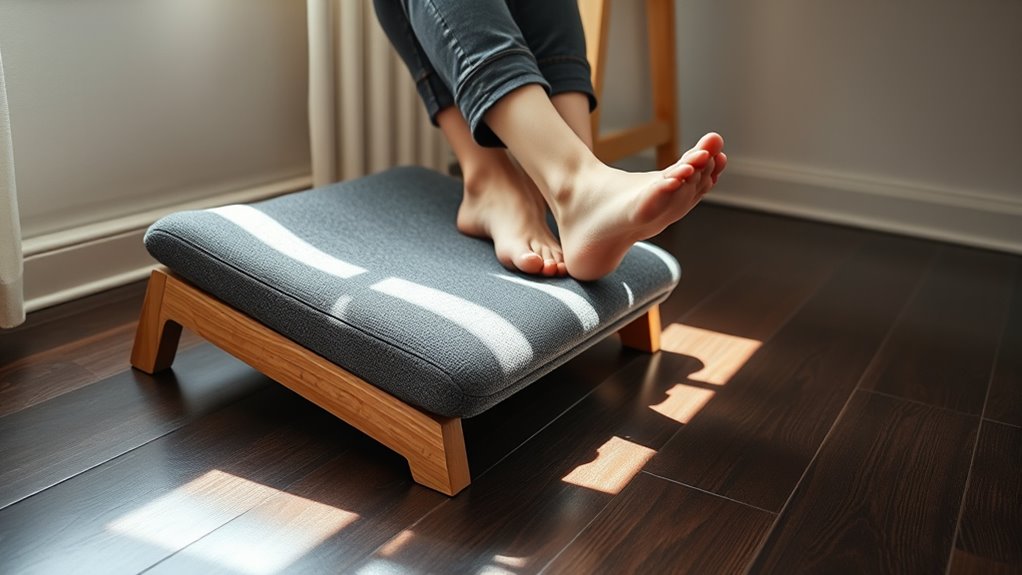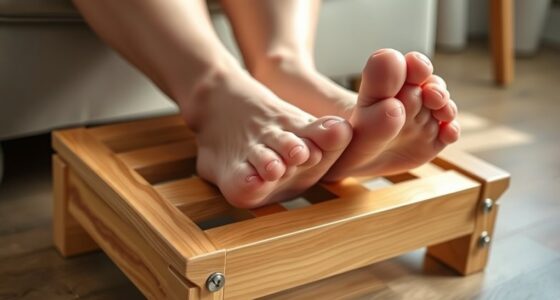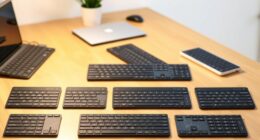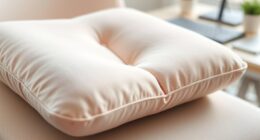To improve circulation while seated, you can create a DIY footrest using household items like sturdy cardboard, wooden blocks, or old cushions. Elevate your feet with a stable platform that keeps your knees at about 90°, reducing pressure on your lower back and promoting healthy blood flow. Covering your makeshift footrest with fabric or tape gives it a finished look and adds comfort. Keep exploring if you want even more tips for customizing your ergonomic solution.
Key Takeaways
- Use sturdy household items like boxes or wooden blocks stacked to the desired height for adjustable support.
- Wrap platforms with fabric or tape for a polished look and added durability.
- Incorporate soft cushions, towels, or foam panels on top for comfortable foot support.
- Ensure the footrest elevates feet slightly, with knees at about 90° for optimal circulation.
- Regularly adjust and evaluate the height to maintain proper posture and improve blood flow.

If you spend long hours sitting at a desk, a comfortable footrest can make a significant difference in your posture and overall comfort. When considering DIY solutions, focusing on ergonomic design is vital. An ergonomic footrest supports your legs and promotes proper alignment, reducing strain on your lower back and hips. You don’t have to spend a fortune to create an effective, supportive footrest. Budget-friendly options are abundant, and with a little creativity, you can craft a solution tailored to your needs.
Start by evaluating what materials you have at home. A sturdy cardboard box, for example, can serve as a basic platform. Reinforce it with additional layers for stability, and add a soft cushion on top for comfort. For a more polished look, wrap the box with fabric or adhesive tape. This simple setup elevates your feet and encourages better circulation without breaking the bank. If you want a slightly more sophisticated DIY, consider stacking hardcover books or sturdy wooden blocks. These can be easily adjusted for height, allowing you to find the most comfortable position. Just make sure the stack is stable and won’t wobble, to prevent accidents.
For a more cushioned experience, you can repurpose items like foam panels, old pillows, or even a folded towel. Placing these on top of your makeshift platform provides added softness and comfort. If you’re handy, you might even assemble a custom footrest using wooden pallets or scrap wood, sanding down rough edges for safety. Painting or decorating it can give it a more finished look, blending seamlessly into your workspace. The key is to prioritize ergonomic design—your feet should be slightly elevated, with knees at about a 90-degree angle, and your lower back supported. This promotes healthy circulation and prevents numbness or discomfort over long periods.
Additionally, participating in remote hackathons can be an effective way to learn new DIY techniques and connect with others who share similar ergonomic and workspace improvement interests. Ultimately, DIY footrest solutions are all about combining comfort, support, and affordability. You don’t need expensive or complex materials to make a functional, ergonomic footrest. Instead, focus on repurposing household items or inexpensive materials that can be assembled easily. By doing so, you’re creating a workspace that encourages better posture, reduces fatigue, and promotes circulation. With a little effort, you’ll enjoy improved comfort during those lengthy work sessions, all while sticking to your budget. Remember, the best DIY solutions are simple, supportive, and tailored to your specific needs, making your workspace healthier and more comfortable each day.
Frequently Asked Questions
Can DIY Footrests Help With Varicose Veins?
You might wonder if DIY footrests can help with varicose veins. While they won’t cure the condition, a custom design footrest can improve circulation and reduce discomfort. DIY options are cost-effective and let you tailor height and support to your needs. By elevating your legs, you promote better blood flow, easing symptoms. Just guarantee your homemade solution provides stable support and encourages healthy circulation.
What Materials Are Safest for Homemade Footrests?
When choosing materials for your homemade footrest, prioritize safety by selecting non-toxic, hypoallergenic options. Wood, foam, and sturdy fabric are generally safe and easy to work with, making them ideal for DIY design tips. Avoid toxic glues or paints that could harm your skin or emit fumes. Always guarantee your materials are durable and supportive to promote proper circulation and comfort while seated.
How Often Should I Adjust My Footrest Height?
You should adjust your footrest height regularly to maximize ergonomic benefits and prevent discomfort. Aim to change it at least once every few hours or whenever you notice your feet or legs feeling strained. Frequent adjustments help maintain proper circulation and reduce fatigue. Listen to your body; if you feel tension or numbness, it’s time to tweak the height. Consistent adjustment ensures ideal comfort and supports your overall posture.
Are There Any Health Risks With Homemade Footrests?
You might wonder if homemade footrests pose health risks. If you prioritize ergonomic design and use safe, non-toxic materials, risks are minimal. Poorly designed or unstable footrests can cause discomfort, strain, or even falls, so guarantee your DIY solution is stable and comfortable. Always choose materials that are safe and suitable for prolonged contact, and test your footrest regularly to prevent any health issues.
Can a DIY Footrest Improve Long-Term Circulation Issues?
You might wonder if a DIY footrest can truly help with long-term circulation issues. While they may not replace medical treatment, an ergonomic design encourages movement and reduces pressure, promoting circulation benefits over time. By customizing your footrest, you stay comfortable and active during long sitting periods, which can support your overall circulation health. Just verify your homemade solution offers proper support and comfort for sustained benefits.
Conclusion
Creating your own footrest is like giving your legs a gentle hug, boosting circulation and comfort with simple materials. With a little creativity, you can craft a supportive, personalized solution that turns your workspace into a more relaxing oasis. So, don’t wait—build your footrest today and let your legs breathe easy, turning your daily routine into a smooth ride rather than a bumpy road. Your body will thank you for the comfort!









